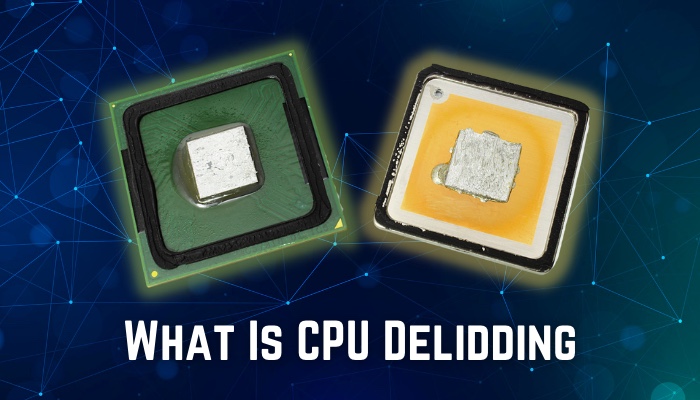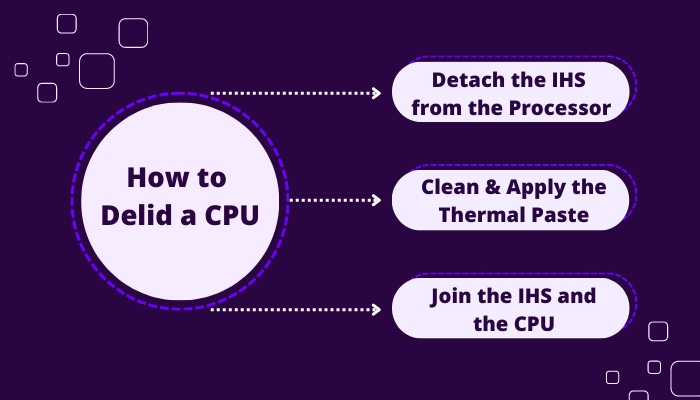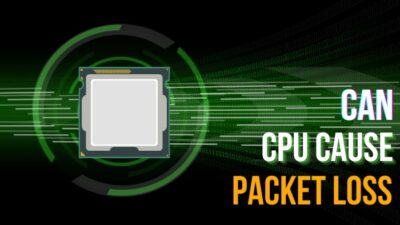As you already know, in regular usage, the temperature of the processor stays within 60 to 70 °C. And when you overclock, it can go over 80 °C.
But with CPU delidding you can reduce the heat and improve the processor’s cooling performance.
So, if you are wondering what CPU delidding is, and how to do that, look no further. Because here, I will explain that and demonstrate whether delidding is worth the risk.
Without further ado, let’s begin.
What is Delidding and Why Should You Do it?
Delidding is a procedure where you detach the IHS (Integrated Heat Spreader) from your CPU and replace the thermal compound with new premium-quality thermal paste or better liquid metal. The main goal to delid a CPU is that it increases the processor’s cooling performance.
Removing the Integrated Heat Spreader to delid processor is a must for those who overclock their PC too often. If you’re one of those overclockers, you should also do delidding as it reduces the CPU die’s temperature and provides a stable operation even when you are overclocking.
Another reason to delid a processor is, after a long time of use, the thermal paste loses its integrity. And the CPU gets hotter than usual, even though you are using your PC for regular work.
So, when you delid your CPU, the paste gets to be changed, and the processor will get less warm. To learn more, read how to clean thermal paste on CPU pins or motherboards.
Go to the next section if you’re eager to know how to delid a processor.
How to Delid a CPU
To delid a processor, open up the IHS from the CPU with the help of a delid die mate or a blade. Remove and scratch off all the old paste from the processor and IHS using microfiber cloths or a credit card. Apply the thermal paste and reattach the IHS with the CPU.
Though it may seem easy, you will require a few specific tools and take proper precautions to delid a processor. Ensure you have all the tools I recommend here.
Warning: The CPU is one of the sensitive components in a PC. So, you must handle it very carefully when you delid your processor. Also, take as much time as you need. A simple wrong move can damage your CPU for good. Moreover, you will lose the warranty once you delid your processor.
Here is the list of tools that requires to delid a CPU:
- A Delidding Tool. Get Delid Die Mate or Delid Die Mate-X.
- Premium quality Thermal Paste or liquid metal. When I delidded my CPU, I used Thermal Grizzly Conductonaut. You can also use that. Alternatively, you can utilize Noctua’s NT-H1.
- Isopropyl Alcohol.
- Nail polish & Heatproof glue.
- Thermal Paste Spreader.
- Microfiber Cloth.
Once you gather all the tools here, you can start to delid your CPU. Below I have explained the whole process in detail. Check these out.
Here is the process to delid a CPU:
1. Detach the IHS from the Processor
The first thing you have to do is to take the processor and delid die mate tool in your hand. If the CPU is in the motherboard, bring it out from there. Don’t delid the processor while it’s still in the motherboard.
Once you have done that, gently insert the IHS remover into the tool. Place the slider in and put in the screw. Ensure the screw and the hole in the CPU retaining holder lineup.
Tighten the screw down with the supplied hex bolt or Allen key. You may also turn it in with your hand. Continue doing so until you are unable to.
After a while, you may feel the screw is not tightening anymore. Don’t worry, it’s pretty normal. Keep spinning and keep a close eye on the CPU.
Stop the spinning at once when you see the IHS has moved slightly. You should also stop if you hear a click at some point.
Beware of your CPU pins! Don’t bend any pins in the process. Read more to know, are bent CPU pins bad. Though you can fix bent pins on a processor, the process is a bit risky. Read our separate article to do it properly.
2. Clean & Apply the Thermal Paste
Now bring out both the processor and IHS from the device and place them on a flat clean surface.
Take a microfiber cloth with some Isopropyl alcohol in it and carefully remove the thermal compound off the IHS and the CPU. Check out another article to know whether you can clean a CPU with rubbing alcohol.
Also, wipe the glue off the IHS and CPU using your credit card, a blunt knife, or a razor blade. Since you are going to add a fresh new layer of glue later.
The benefit of this is by removing the glue, the distance between the heatspreader and the silicon will be shorter, which will improve thermal performance.
Caution: Be careful not to harm the PCB in the process.
In your CPU, there can be gold-plated caps or shorted resistors located near the CPU Die. If you have, apply an insulating material to stop them from shorting out with the thermal material. I used a drop of nail polish on it since it can dry out pretty quickly.
Now, take a small amount of thermal paste on the thermal spreader and apply the compound onto the CPU die nicely and evenly.
Caution: Be careful not to use too much compound, and don’t apply outside the die.
Also, apply the thermal paste on the IHS. Don’t apply too much & make the rectangle too large unless you want to damage your PCB.
It’s time to join the IHS and CPU back again if you complete the applying thermal paste process perfectly.
3. Join the IHS and the CPU
Apply waterproof or heatproof silicone glue along the glue traces on IHS and CPU. However, superglue can do the trick, but I don’t recommend that.
Place the processor in the delidding device. After that, carefully put the IHS on top of the processor.
Adjust the positioning of the IHS with your finger if needed. Put the clamp mechanism on top of the CPU and tighten it so that the clamp can put pressure to join them together.
Keep it that away for a few hours. I didn’t want to risk my processor. That’s why I took out the CPU from the delid device after 24 hours. You can also do that.
Finally, the CPU delidding process is complete.
Now comes the moment of truth. Place the processor back on your motherboard and reassemble your PC.
If the CPU work after the delidding and the temperature is lower than before, you can pat yourself on the back for the job well done.
I delidded my Intel Core i9-12900K & its temperature went down from 66 °C to 54 °C after that.
So you see how the delidding process can solve the overheating issue. But be very careful at every step of the process because one wrong move can stop the PC from working correctly.
Is It Worth It to Delid a CPU?
Yes, it’s worth it to delid a CPU. Because, after the delidding, the processor will cool more efficiently even if you overclock. If you don’t overclock, you get to replace the thermal paste with new good quality thermal material, which will help the CPU stay cool even more.
However, there are other benefits of delidding. For example, let’s say your PC always stays over 80 °C. And you think that the CPU is the main reason your computer is getting warmer.
When you delid the processor, the extra hot issue should be fixed. In case, it doesn’t fix, you can assure the problem isn’t on the CPU, instead, it’s on the other PC components.
Regardless of the benefits, there is one major drawback. It is, when you delid your CPU, the warranty will be lost.
By any chance, if the CPU doesn’t work after you delid, you can’t change or fix the processor from your buyer or manufacturer.
Either you have to fix it from a local shop, otherwise, you must buy another CPU.
FAQs
Why would you delid your CPU?
The reason you would delid your CPU is to add an alternative thermal paste between the IHS and CPU chipset so that the processor can stay even cooler while it operates.
What is CPU lapping?
CPU lapping is a process where you keep the pressure on the top of the CPU case until it closes perfectly.
What is a CPU IHS?
CPU IHS (Integrated Heat Spreader) is the surface that stays on the CPU chipset. Its function is to bring out the heat that is generated by the processor.
What is the CPU lid made of?
The CPU lid is made of copper or aluminum. Most of the time, copper is used because of its excellent heat dissipation ability.
Conclusion
Delidding is quite a risky procedure. There is no guarantee that the cooling performance of your CPU will increase after you delid your CPU. So, do it at your own risk.
I hope you get all your answers in this article and have no confusion on delidding a CPU.
Comment below if you have any queries.
Peace out!




